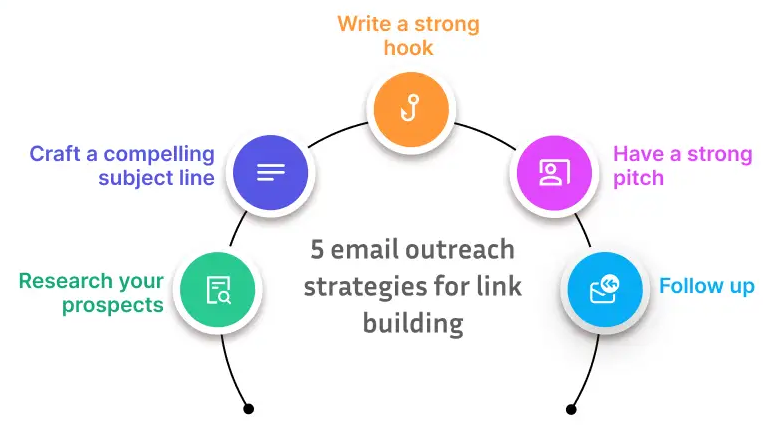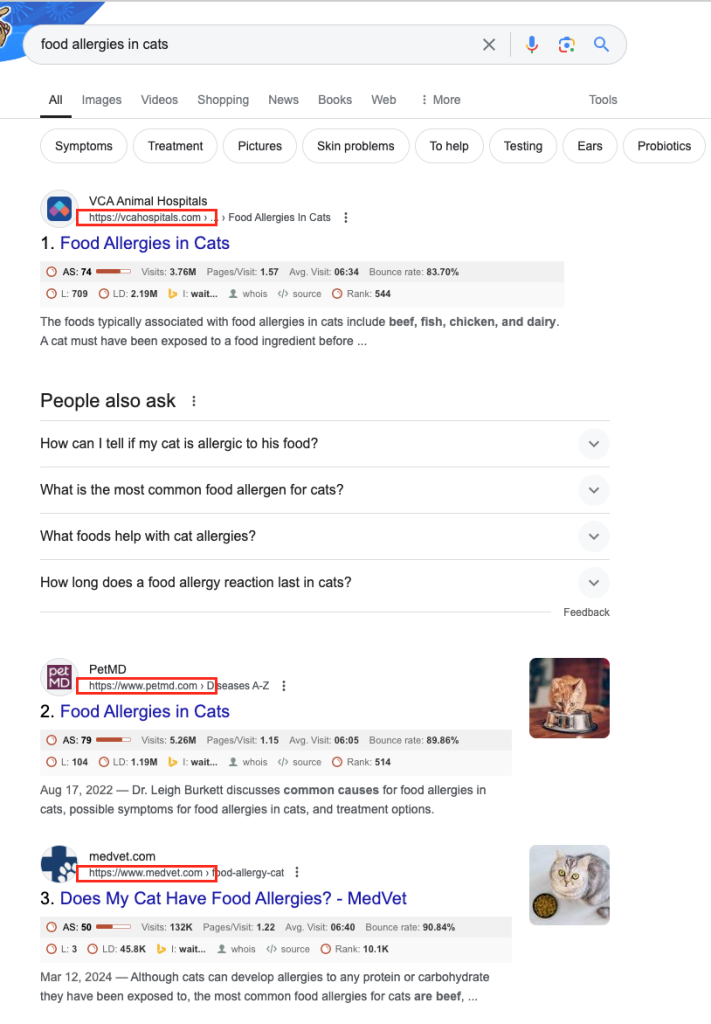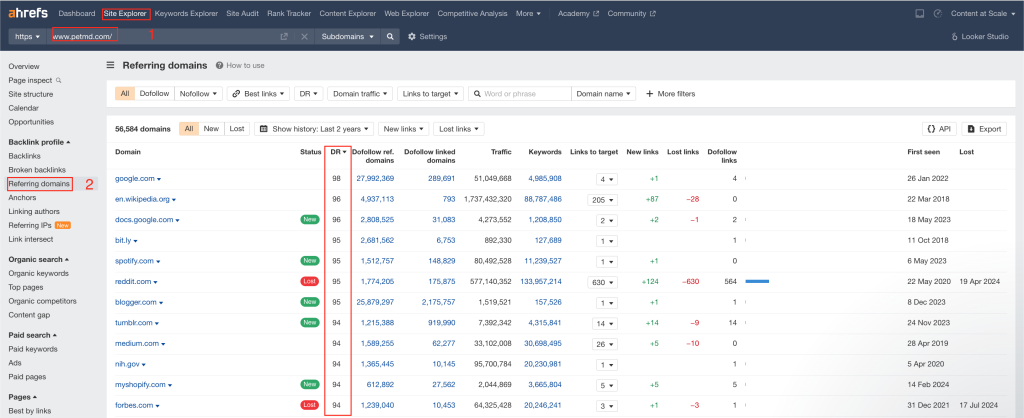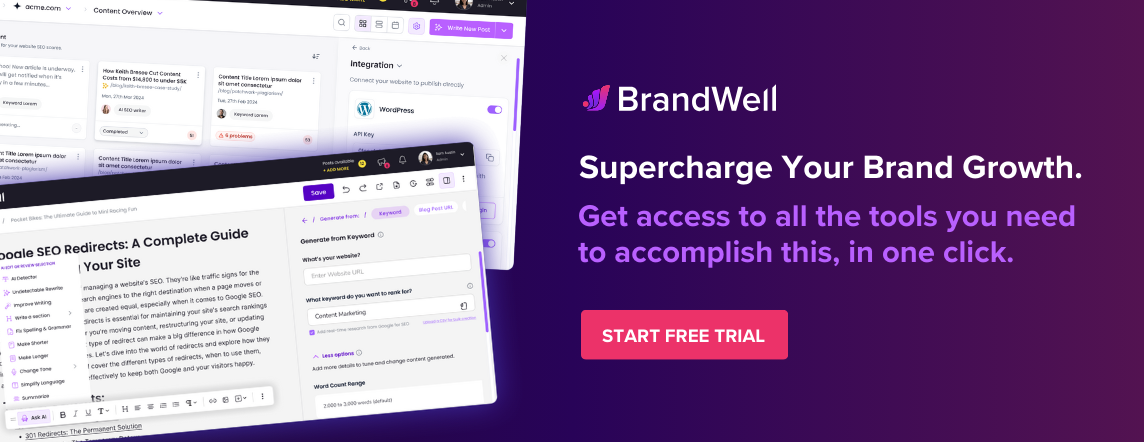Discover top guides, trends, tips and expertise from AIO Writers
Link Building Email Outreach: Essential Tips and Templates
Julia McCoy
Sunday, 14th Apr 2024
Links matter. While we might not know if they’re still in the top three ranking factors, we do know that Google (and other search engines) care more about you when you have a strong vote from an authoritative domain.
Think of it like this: if you have two restaurants nearby, and one is recommended by your favorite trusted food blogger while the other hasn’t been reviewed, which one would you choose? Exactly, we don’t even need to ask.
Getting links naturally isn’t always a walk in the park, and snagging valuable backlinks goes beyond just creating awesome content. Sometimes, you need to reach out and connect with other webmasters and bloggers in your niche.
Email outreach is one of the most powerful tools in a link builder’s toolkit. Crafting compelling outreach emails can be the difference between landing high-quality backlinks or getting ignored (or worse, ending up in the spam folder).
In this blog post, I’ll share some tips and templates on how to create the perfect pitch for your link-building email outreach. These strategies have been personally tested and proven to help secure valuable links.
Table Of Contents:
- What Is Link Building Outreach?
- How to Find Link-Building Opportunities
- 5 Tips on How to Write the Perfect Link-Building Outreach Email
- Best Practices for Link Building Outreach
- Link Building Outreach Templates You Can Use Now
- Common Link Building Email Outreach Mistakes to Avoid
- Measuring the Success of Your Link-Building Outreach
- FAQs – Link Building Email Outreach
- Conclusion
What Is Link Building Outreach?
Link building email outreach is the secret sauce of link-building. It’s how you directly connect with website owners and editors to ask for those valuable backlinks. When done right, it can be incredibly effective. Think of it like networking, but from the comfort of your own desk.
Why Is Email Outreach Important?
Ever open your email inbox and get bombarded with link-building offers? Yeah, it can get really annoying, and often those emails end up ignored or flagged as spam. Since email outreach can easily go south, it’s crucial to pay attention to a few key factors to avoid the spam folder and make a real impact.
5 Tips for Writing the Perfect Link-Building Outreach Email
When you’re reaching out to a high-profile author, remember you’re not the only one doing it. You can’t just throw together a generic message and expect it to stand out.
Here’s how to craft link-building emails that get noticed and deliver results:
1. Personalize Your Outreach
Personalization is the name of the game for successful outreach. No one wants to receive a genric email that’s clearly been sent to a ton of other people. Put in a little effort to research the site and the person you’re reaching out to.
Address them by name, mention something specific about their site or content, and tailor your pitch to their interests. Just saying you’re impressed by their article [URL] doesn’t cut it. The author is probably getting a bunch of similar emails every day (how many of those do you get, by the way?). Show them you’ve really done your homework—it’ll make a big difference in your response rates.
But be careful not to cross the line into creepy territory. Keep it professional and avoid getting too personal.
True personalization means understanding their needs and offering a solution that hits the mark.
2. Write Compelling Subject Lines
Your subject line is the first thing recipients will see, so it needs to be attention-grabbing and compelling. Avoid generic phrases like “Guest Post Inquiry” or “Link Request.” Instead, get creative and pique their curiosity.
Try subject lines like “Quick question about your [specific article/page]” or “Content suggestion for [website name].” Make it clear that your email is personalized and relevant to their website.
Also, make sure your subject line matches what’s in the email. There’s nothing worse than expecting one thing and getting another. So, walk the line between piquing their interest and being honest—raise curiosity, but don’t mislead!
3. Provide Value in Your Email
Here’s the thing – no one wants to link to your content just because you asked nicely. A line like “I think linking to our article will add value to your article” won’t cut it. You need to offer something valuable in return to give them a reason to care.
You can highlight the unique insights, data, or expertise that your content offers. But sometimes, you need to go a step further. What can you offer them in exchange?
One option is the ABC link exchange. Here’s the deal: if you link to my site (A) from yours (B), I’ll then link from a different site (C) to your site (B). We use a third-party site because Google doesn’t like it when you do direct link swaps — like “you link to me, and I’ll link to you.”
This can look a bit shady and might even get you penalized. So, unless you’re totally sure about what you’re doing, it’s best to avoid a reciprocal linking approach and go for something like the ABC exchange instead.
Another approach is a bit more involved. Instead of owning a third domain yourself, build relationships with other website owners who do. You can then use their domains for the exchange. This requires maintaining a good network of contacts and keeping track of your exchanges to ensure a balanced 1:1 ratio. It can get a bit tricky, but many link builders and agencies use this tactic because it’s all about leveraging connections.
If that’s not possible, consider offering something like a free trial or product that’s not available to the public. The key is to offer something of equivalent value or more in return for the link.
4. Keep Your Email Concise
Keep your outreach emails short and sweet. Website owners and editors are busy people, and they don’t have time to read a thousand words. Aim for around 150-200 words, focusing on the key points and benefits.
Use short paragraphs, bullet points, and clear language to make your email easy to read and understand. Get to the point quickly and make your request clear. The easier you make it for them, the more likely they are to respond positively.
For more tips, check out: How To Write an Email
5. Include a Clear Call-to-Action
Don’t leave them guessing what you want them to do. End your email with a clear call-to-action (CTA) that specifies exactly what you’re asking for. Whether it’s adding your link to their content, considering your guest post pitch, or sharing your content on social media, make it crystal clear.
Use phrases like “Please let me know if you would be interested in adding our resource to your page” or “If you’re open to guest post submissions, I’d be happy to send over some topic ideas for your review.” Make it easy for them to say yes and take action.
Remember, crafting the perfect link-building email is all about personalization, value, and clarity. Put yourself in the recipient’s shoes and think about what would make them want to open, read, and respond to your email. With a little effort and creativity, you’ll be landing those backlinks in no time.


Types of Link-Building Outreach Emails
Now, there’s no one-size-fits-all approach to link-building email outreach. Different situations call for different types of emails.
Here are a few common ones:
- Broken link-building emails: You find a broken link on their site and suggest your content as a replacement. It’s like being a helpful neighbor but with SEO benefits.
- Guest post pitch emails: You offer to write a killer guest post for their blog, including a link back to your site. It’s a chance to showcase your expertise and get a backlink in return.
- Resource suggestion emails: You recommend your top-notch content as a valuable addition to their existing articles or resource pages. It’s all about providing value to their readers.
- Skyscraper technique emails: You take an existing piece of content, make it even better, and then reach out to websites that link to the original, asking them to link to your improved version instead.
The key is to tailor your outreach email to the specific situation and website. No generic copy-paste email templates.
How to Find Link-Building Opportunities
Alright, so you’re sold on the power of link-building outreach. But where do you even start? How do you find those golden link opportunities?
Identify Relevant Websites
The first step is to find websites that are relevant to your niche or industry. A link from a medical site to a tech site is just not going to help anyone. Here’s how to get started:
Use your target keywords to find websites that cover similar topics and target the same audience. For example, if you have a pet site and you’re focusing on “food for allergic cats,” Google a related phrase:


Now you’ve got two main choices:
- Reach Out to These Sites Directly: Drop them a line and ask for a link.
- Check Who Links to These Sites: See which sites are linking to them AKA your competitors.
Want a little secret? Go with the second option! Your competitors can be a goldmine for link-building. By checking out the sites that link to your competitors, you can find great targets for your own outreach.
Analyze Competitor Backlinks
Let’s dive into who’s linking to your competitors. If these sites find value in your competitors’ content, there’s a good chance they might link to you too! Here’s a little secret sauce for you:
Find Competitors at Your Level: Look for competitors who are as authoritative as you are, or a bit higher or lower. If you just launched your site last month, don’t aim for the biggest names in your industry just yet.
How to do it? Tools like Ahrefs, Semrush, and Moz make it easy to spy on your competitors’ backlinks and identify link prospects. Let’s use Ahrefs as an example:


- Input the domains you found through your Google search into Ahrefs’ “Site Explorer.” For this demo, I searched the second result since it was offering a service similar to mine.
- From the left sidebar, go to “Referring Domains” or “Backlinks.” Referring domains will show you the domain that links to your competitor.
- Check the list, pick out the websites, find their contact info, and reach out.
Make sure to evaluate the sites. While sites like Spotify and Forbes might show up, they’re usually way out of reach for just an email outreach and require some digital PR. Look for sites with more reasonable metrics.
After you’ve narrowed down your list, use email finder tools like Hunter or manually go to the website’s contact page. Find someone who handles content, SEO, or outreach.
Avoid emailing irrelevant team members like developers; instead, try to connect with content specialists or SEO managers. If needed, you can add a line in your email asking them to forward your message to the right person.
Who you email is crucial for your open and response rates. So, be thoughtful about your outreach!
Best Practices for Link Building Outreach
You’ve got your link-building strategy all mapped out. You know who you want to reach out to and what you want to say. But before you hit that “send” button, let’s talk about some best practices in link-building email outreach.
Timing Your Outreach
When it comes to link-building email outreach, timing is everything. You want to catch your prospects when they’re most likely to be receptive and have the time to consider your request.
Generally, the best days to send outreach emails are Tuesday, Wednesday, and Thursday. People tend to be more focused and engaged during the middle of the week. Mondays are often hectic as people catch up from the weekend, and Fridays, well, everyone’s got their eye on the weekend prize.
Pro Tip: As for the best times to send, studies suggest that 10 a.m. and 8 p.m. to midnight are peak open times. But don’t be afraid to experiment and see what works best for your audience. Also, remember to adjust for your prospect’s time zone to make sure your email lands at the right moment.
Following Up Effectively
So, you’ve sent your perfectly timed outreach email, but you haven’t heard back. Don’t worry, it happens to the best of us. In fact, a study by Backlinko found that only 8.5% of outreach emails receive a response.
That’s where the follow-up comes in. A gentle nudge can often be the key to getting a response. Wait about 3-5 days after your initial email, then send a polite follow-up. Reiterate your request and highlight the value you’re offering.
Just remember, there’s a fine line between persistence and being a pest. Limit your follow-ups to 2-3 max, and always give the option to opt out of future communications. Don’t know how to properly follow up? We have some follow-up templates collected here.
Tracking Your Results
You can’t improve what you don’t measure, right? Tracking your link building email outreach results is crucial for refining your strategy and maximizing your success.
Keep a spreadsheet of the sites you’ve contacted, the status of each outreach attempt, and the links you’ve successfully acquired. Monitor key metrics like open rates, response rates, and conversion rates.
Tools like Mailtrack, Yesware, or your email provider’s analytics can give you valuable insights into your outreach emails’ performance. Use this data to A/B test different subject lines, messaging, and timing to see what resonates best with your audience.
Building Relationships
Here’s the thing about link building – it’s not just about the links. It’s about the relationships you build along the way. Every outreach email is an opportunity to connect with someone in your niche, start a conversation, and offer value.
So don’t just focus on the ask. Focus on the give. Share their content on social media. Leave thoughtful comments on their blog posts. Offer your expertise or resources. Nurture these relationships over time, and you’ll find that the links often follow naturally.
Remember, link-building is a long game. It’s about consistency, authenticity, and always putting your best foot forward. Master these outreach best practices, and you’ll be well on your way to building the high-quality links your site deserves.
Link Building Outreach Templates You Can Use Now
You’ve learned the best practices, built your prospect list, and are ready to start your link-building email outreach. But you’re staring at that blank email screen.
Let me help you get started. Here are some tried-and-true templates from link-building experts customized for every link-building scenario.
Broken Link Building Template
Broken link building is a win-win. You get a high-quality link, and your prospect gets to fix a broken link on their site. Here’s a template to get you started:
Subject: Broken link on [Website Name]
Hi [Name],
I was browsing your excellent resource on [topic] when I noticed a broken link. The link to [broken URL] on [page title] seems to be no longer working.
I recently wrote an in-depth guide on [your topic] that might make a good replacement: [your URL]
Just thought I’d bring it to your attention. Keep up the great work.
Cheers,[Your Name]
Guest Post Pitch Template
Guest posting is a fantastic way to build links and establish yourself as an authority in your niche. Use this template to craft a compelling pitch:
Subject: Guest Post Idea for [Website Name]
Hi [Name],
I’m a huge fan of [Website Name]. Your recent post on [topic] was spot on and gave me a lot to think about.
I’m writing to propose a guest post that I think your audience would love. It’s titled “[Proposed Title]” and covers [brief description]. I believe it would be a perfect fit for your [category/section].
To give you an idea of my writing style and expertise, here are a couple of my recent posts:
- [URL 1]
- [URL 2]
Let me know if you’re interested, and I’ll send over a draft for your review.
Thanks for your consideration,[Your Name]
Resource Suggestion Template
If you’ve created a valuable resource that you think would enhance someone else’s content, use this template to suggest it:
Subject: Resource for your [topic] post
Hi [Name],
I loved your recent post on [topic]. The way you explained [specific point] was brilliant.
I wanted to quickly reach out because I’ve created a [resource type] on [topic] that I think would make an excellent addition to your post. It covers [key points] and has [unique feature/benefit].
You can check it out here: [URL]
No pressure at all, but if you think it would be helpful to your readers, I’d be honored if you considered adding it to your post.
Either way, keep up the fantastic work.
Best,[Your Name]
Skyscraper Technique Template
The skyscraper technique involves finding popular content, creating something even better, and then reaching out to people who linked to the original piece. Here’s how to do it:
Subject: I made your [topic] post even better
Hi [Name],
I was doing some research on [topic] when I came across your excellent post: [URL]
It’s a great resource, but I noticed it was a bit outdated. So I decided to create an updated, more comprehensive version: [your URL]
It includes [key improvements/additions] and [unique feature/benefit]. I thought it might be a valuable resource for your readers.
If you agree, I’d be thrilled if you considered updating your post with a link to my version.
Either way, thanks for the inspiration and keep up the great work.
Cheers,[Your Name]
Remember, these templates are just a starting point. Always personalize them to your specific outreach scenario and the person you’re contacting. A little extra effort can go a long way in getting those coveted links.
Common Link Building Email Outreach Mistakes to Avoid
You’ve got your templates, you’ve crafted your perfect pitch, and you’re ready to hit send on your link-building email outreach. But before you do, let’s talk about some common mistakes to avoid.
Sending Generic Emails
You know those emails that start with “Dear Sir/Madam” or “To Whom It May Concern”? Yeah, don’t do that. Generic, templated emails are a surefire way to get your outreach ignored or, worse, marked as spam.
Instead, take the time to personalize each email. Use the recipient’s name, mention something specific about their site or content, and tailor your pitch to their interests.
Failing to Personalize
Personalization goes beyond just using someone’s name. It’s about showing that you’ve actually read and engaged with their content. Don’t just say “I love your blog.” Point out a specific post, quote, or insight that resonated with you.
For example: “Your recent post on [topic] really got me thinking, especially when you mentioned [specific point]. It’s a perspective I hadn’t considered before.”
This level of detail shows that you’re not just blasting out a generic email template, but that you’ve taken the time to understand their work and find a genuine connection.
Being Too Pushy
Link-building email outreach is all about finesse. You want to be assertive and persuasive, but not aggressive or pushy. Avoid language that pressures the recipient or makes demands.
For instance, instead of saying “I need you to link to my site,” try “I would be honored if you considered linking to my resource.”
Remember, you’re asking for a favor, not demanding a right. Approach your outreach with gratitude and respect, and you’ll be much more likely to get a positive response.
Not Providing Value
Here’s the golden rule of link-building email outreach: always provide value. Your outreach should never be just about getting a link. It should be about offering something of worth to the recipient and their audience.
Before you reach out, ask yourself: What’s in it for them? How does linking to your content benefit their readers? What unique insights, data, or resources are you bringing to the table?
If you can’t answer those questions, you’re not ready for outreach. Focus on creating truly valuable, link-worthy content first, then use that as the foundation for your outreach efforts.
Measuring the Success of Your Link-Building Outreach
You’ve sent out your link-building outreach emails, crossed your fingers, and maybe even said a little prayer. But how do you know if your efforts are actually paying off?
Measuring the success of your link-building email outreach is crucial for understanding what’s working, what’s not, and how you can improve your strategy moving forward.
Tracking Email Metrics
First things first, let’s talk about email metrics. These are the numbers that give you a glimpse into how your outreach emails are performing. Here are a few key metrics to track:
- Open rates: The percentage of recipients who opened your email. A high open rate means your subject line is catching their attention.
- Response rates: The percentage of recipients who replied to your email. This is a good indicator of how compelling your pitch is.
- Conversion rates: The percentage of outreach emails that resulted in a successful link placement. This is the ultimate goal, after all.
To track these metrics, you can use tools like Mailtrack, Yesware, or your email service provider’s analytics. Keep an eye on these numbers and look for patterns. If your open rates are low, try tweaking your subject lines. If your conversion rates are lackluster, it might be time to rethink your pitch.
Monitoring Backlink Growth
Of course, the whole point of link-building outreach is to, well, build links. So, it’s important to monitor your website’s backlink profile growth over time. This will give you a big-picture view of how your outreach efforts are impacting your site’s authority and search engine rankings.
There are plenty of tools out there to help you track your backlinks, like Ahrefs, Majestic, and Google Search Console. Look for steady growth in the number of referring domains and high-quality, relevant links from authoritative websites in your niche.
Analyzing Referral Traffic
Finally, don’t forget about referral traffic. After all, the ultimate goal of link building is to drive traffic to your website. Use Google Analytics to monitor the number of visitors coming from each referring website, as well as their engagement metrics like bounce rate and time on site.
High-quality links from relevant websites should drive targeted traffic that engages with your content and contributes to your overall website goals. If you’re seeing a lot of referral traffic but high bounce rates, it might be a sign that the linking website isn’t as relevant to your audience as you thought.
FAQs – Link Building Email Outreach
What is email outreach in link building?
Email outreach means shooting a message to website owners, aiming to snag a backlink that boosts your site’s SEO juice.
How do I reach out for link building?
Pick relevant sites, craft a personalized pitch highlighting mutual benefits, and keep it short. A clear ask wins the game.
How to do outreach for backlinks?
Dig up contacts from sites you admire. Shoot them an engaging, value-packed email. Remember, it’s about what you can offer them.
How do you ask for a link building?
Straight talk works best. Be upfront about wanting a link but focus on how linking up serves their audience too.
Conclusion
Link-building email outreach is not just another task on your white hat link-building checklist; it’s an art form rooted in genuine connection and strategic communication.
Becoming adept at sending these targeted cold emails can help you forge relationships that nail those crucial links for your website.
Remember: the right approach can turn cold email prospects into warm leads.

UNLOCK YOUR POTENTIAL
Long Headline that highlights Value Proposition of Lead Magnet
Grab a front row seat to our video masterclasses, interviews, case studies, tutorials, and guides.



